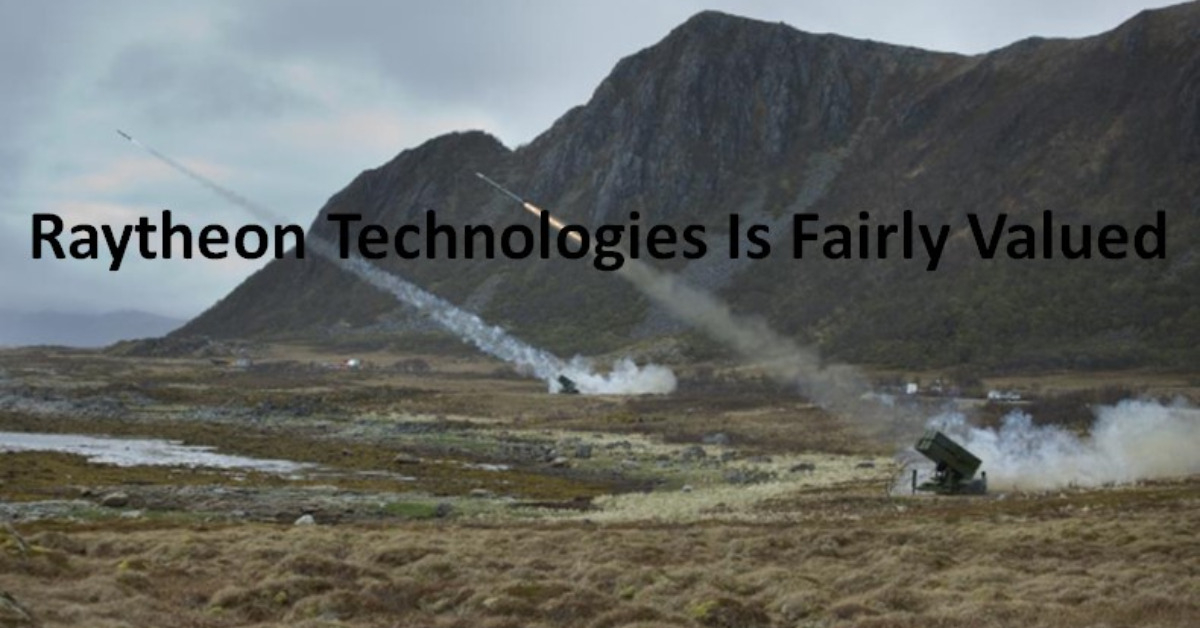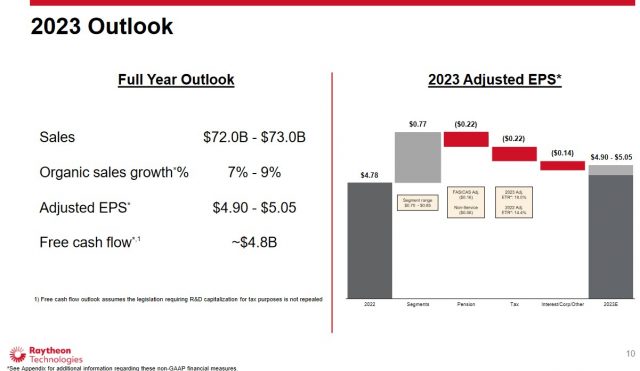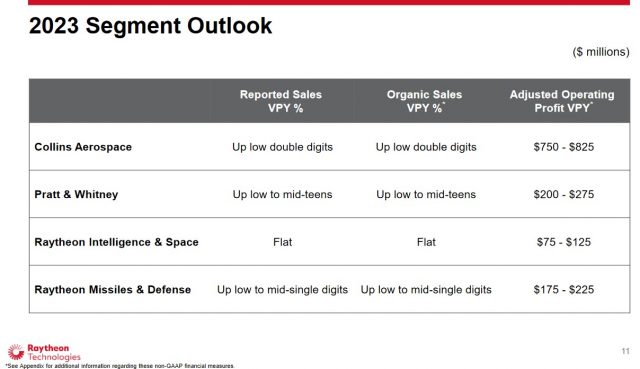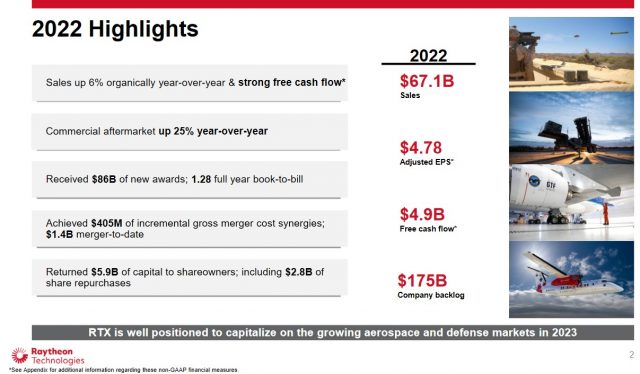Contents

I last reviewed Raytheon Technologies (RTX) in this July 27, 2022 post. With the January 24, 2022 release of Q4 and FY2022 results and FY2023 outlook, I revisit it to determine whether I should add to my exposure.
Business Overview
Investors unfamiliar with RTX are encouraged to review the company's website and Part 1 Item 1 within the 2021 Annual Report and Form 10-K; RTX's FY2022 Form 10-K is currently unavailable.
The Risk Factors section within RTX's Form 10-K provides a good overview of various risks that could impact RTX's business, financial condition, operating results and cash flows.
In 2020, the United Technologies Corporation's aerospace business and Raytheon Company were combined to become a pure-play aerospace and defense company. At the time of this merger, management lay out the following 2025 goals:
- $20B of capital return to shareowners in the first 4 years (2020 – 2025) following the merger;
- Sales growth: +6 – 7% CAGR;
- Adjusted margin expansion: +550 – 650bps; and
- Free cash flow: $10B+
The combined entity is now approaching the 3rd anniversary of this merger having realized gross cost synergies of $1.4B.
While many objectives have been accomplished, RTX is embarking on the next step in its integration and evolution. The plan is to streamline the structure to a customer-centric organization with 3 focus segments: Collins Aerospace, Raytheon and Pratt & Whitney. RTX currently consists of 4 segments: Collins Aerospace, Pratt & Whitney, Raytheon Intelligence & Space, and Raytheon Missiles & Defense.
Throughout this evolution, RTX continues to identify labour availability as a constraint. Some progress, however, has been made through reduced attrition and other strategic retention and recruiting initiatives.
Ongoing progress is being made in restoring health within the supply chain and RTX maintains a physical presence at close to 400 supplier sites. In addition, RTX continues to qualify additional suppliers on key programs and it has secured sources of supply for critical commodities.
Despite improvements in the supply chain, further improvements are required and the assumption is for a recovery in the 2nd half of FY2023.
RTX is expecting roughly $2B of labour and material inflation in 2023. It is, therefore, taking action to deal with elevated levels of inflation and is targeting to more than offset this headwind through higher pricing and aggressive cost reduction actions across the entire organization.
Financials
Q4 and FY2022 Results
Until RTX releases its FY2022 Form 10-K, refer to its most recent results reflected in the Form 8-K and Earnings Presentation that were released on January 24.
In FY2022, RTX captured $86B in new bookings, resulting in backlog growth of 12%, a book-to-bill of 1.28 and a near-record backlog at the end of the year of $175B. Of this backlog, ~$106B is from commercial aerospace and ~69B is from defense.
Additionally, RTX was also granted over 2,600 patents in FY2022 thereby placing it in the top 10 companies in the United States for the 2nd consecutive year.
NOTE: A book-to-bill ratio measures supply and demand and represents the ratio of orders received to units shipped and billed for a specified period. When this performance and outlook ratio exceeds one, the implication is that more orders were received than filled (strong demand). Where the ratio is below one, the implication is that there is weaker demand.
RTX also invested $9B in R&D and CapEx. This allowed it to bring new technologies to market and drive further automation and digitization through each phase of the product lifestyle.
FY2023 Outlook
The following reflects RTX's FY2023 outlook and segment outlook.

Source: RTX - Q4 2022 Earnings Presentation - January 24, 2023

Source: RTX - Q4 2022 Earnings Presentation - January 24, 2023
Commercial Aerospace
Expectations are for:
- commercial aftermarket revenue growth across the aerospace businesses to approach 20% in 2023. Commercial production rates are quickly accelerating and expectations are for commercial aircraft volumes to be up ~20% YoY;
- growth in global air traffic to fully recover to 2019 levels which is consistent with what RTX is hearing from the airlines;
- China, which has historically represented about 14% of global air traffic, to continue to gradually lift COVID restrictions and for traffic levels to be robust; and
- resiliency in air traffic in other parts of the world.
Defense
RTX's Intelligence & Space Segment and its Missiles & Defense Segment experienced a YoY decline in Sales and Operating profit that was attributed primarily to lingering supply issues hampering productivity. As noted earlier, this is likely to persist until at least the second half of 2023.
RTX's backlog, however, should continue to grow given the heightened and increasingly complex threat environment. As a result, I consider the current operating conditions to be delaying but not destroying RTX's opportunities.
Furthermore:
- In the U.S., RTX continues to see strong bipartisan support as evidenced by the adoption of the Defense Authorization Bill and the Omnibus Appropriations Bill with a budget of $858B which is a ~10% increase from 2022;
- The EU is targeting a €70 billion increase in defense spending over the next 3 years; and
- Japan will increase its defense budget by 26% in 2023.
RTX participates in the production of Stinger and Javelin missiles, high-speed, anti-radiation missiles (HARMS) and National Surface-to-Air Missile Systems (NASAMS), and the Patriot missile-defense systems the U.S. is sending to Ukraine.
On December 3, 2022, RTX's Technologies CEO spoke about US defense industrial production during a panel on Ukraine at the Reagan National Defense Forum, a high-profile defense-industry confab that attracts a bipartisan congressional delegation, defense contractors, and top Pentagon officials every year.
Although RTX produces 400 Javelins/month with manufacturing partner Lockheed Martin (LMT), the ongoing fighting in Ukraine has burned through existing weapons stocks. In the first 10 months of Russia's invasion of Ukraine, for example, 13 years’ worth of Stinger production and 5 years’ worth of Javelin production was used. As of May 2022, Washington had sent 5,500 Javelins and 1,400 Stingers to Ukraine.
The issue is how to resupply and restock inventories to meet demand. The need to restock is even more urgent considering billions of dollars worth of Javelin and Stinger sales ordered by Taiwan in 2015, have not yet been shipped; Taiwan faces an increasingly acute threat from China.
FY2023 Free Cash Flow (FCF) Outlook
The following is RTX's FY2023 FCF outlook.

Source: RTX - Q4 2022 Earnings Presentation - January 24, 2023
Credit Ratings
Since RTX's FY2022 Form 10-K is not yet available, I reference the most current schedule of RTX's long-term debt (Q3 2022 Form 10-Q) which is as of September 30, 2022 (pages 13 and 14 of 62). At the end of Q3, RTX had ~$31B of LTD and $0.571B matures in 2023. In Q4, RTX issued and repaid no long-term debt, and therefore, still has a similar amount owing on both line items.
LTD that matures in FY2024 - FY2027 only amounts to ~$1.25B, ~$1.5B, ~$0.72B, and ~$2.917B. I do not foresee an issue with RTX repaying its obligations.
Moody's currently assigns a Baa1 rating to RTX's senior unsecured domestic currency debt. This is the top tier of the lower medium-grade category.
This rating defines RTX as having an ADEQUATE capacity to meet its financial commitments. However, adverse economic conditions or changing circumstances are more likely to lead to a weakened capacity to meet its financial commitments.
S&P Global continues to assign an A- rating with a negative outlook. This rating is one notch higher than that assigned by Moody's and is the lowest tier of the upper-medium grade category.
S&P's rating defines RTX as having a STRONG capacity to meet its financial commitments. However, it is somewhat more susceptible to the adverse effects of changes in circumstances and economic conditions than obligors in higher-rated categories.
Both ratings are investment grade and are acceptable for my purposes.
Dividend and Dividend Yield
Looking at RTX's dividend history, the 4th and final $0.55/share quarterly dividend will likely be declared in early February for distribution in late March. I then expect the declaration of a ~$0.04 - ~$0.05/share increase in late April for distribution in mid-June.
When I wrote my January 26, 2022 post, shares were trading at ~$90. The quarterly dividend was $0.51 thus resulting in a ~2.27% dividend yield.
At the time of my July 27, 2022 post, the quarterly dividend was $0.55. With shares still trading at ~$90, the dividend yield was ~2.44%.
Shares now trade at ~$97.60. We can expect one more $0.55 quarterly dividend and then a ~$0.59 - ~$0.60 quarterly dividend commencing in mid-June. The forward dividend yield using the current share price is ~2.4% ($0.55 + (3 x $0.595)).
RTX distributed $2.732B, $2.957B, and $3.128B of dividends in FY2020, FY2021, and FY2022.
RTX's weighted average number of issued and outstanding shares in FY2011 - FY2022 (in millions rounded) is 907, 915, 912, 883, 826, 799, 810, 864, 1,358, 1,509, and 1,486. The weighted average was 1,476.3 in Q4.
The significant increase in RTX's share count is primarily due to the merger of United Technologies Corporation's aerospace business and Raytheon Company on April 3, 2020.
On December 12, RTX announced that its Board had authorized the repurchase of up to $6B of outstanding common stock. This new authorization replaces the company's previous program that had been approved on December 6, 2021.
In FY2022, RTX repurchased ~$2.8B of its shares. Together with the distribution of $3.128B of dividends, this combined $5.928B exceeded RTX's ~$4.9B of FCF. This $1B shortfall came from changes in RTX's working capital.
On the Q4 earnings call, management indicated it expects to repurchase ~$3B of its shares in 2023, subject to market conditions.
Valuation
Please refer to my July 27, 2022 post in which I touch upon RTX's valuation at the time of previous RTX posts.
At the time of my July 27, 2022 post, the current forward-adjusted diluted PE valuations based on broker guidance available from the 2 trading platforms I use were:
- FY2022: 17 brokers, mean estimate $4.71, low/high range $4.55 – $4.80. The valuation using the mean estimate is ~19 and ~18.8 using the upper end of the range.
- FY2023: 16 brokers, mean estimate $5.69, low/high range $5.18 – $6.21. The valuation using the mean estimate is ~15.8 and ~14.5 using the upper end of the range.
- FY2024: 11 brokers, mean estimate $6.54, low/high range $5.28 – $7.23. The valuation using the mean estimate is ~13.8 and ~12.4 using the upper end of the range.
I expected downward earnings revisions following my published post and cautioned that we would likely have higher valuations than those reflected above.
Shares now trade hands ~$97.60 and management's FY2023 adjusted diluted EPS outlook is $4.90 - $5.05. This gives us a forward-adjusted diluted PE range of ~19.3 - ~20.
RTX's current forward-adjusted diluted PE valuations based on broker guidance are:
- FY2023: 21 brokers, mean estimate $5.01, low/high range $4.68 – $5.24. The valuation using the mean estimate is ~19.5.
- FY2024: 20 brokers, mean estimate $5.85, low/high range $5.25 – $6.34. The valuation using the mean estimate is ~16.7.
- FY2025: 13 brokers, mean estimate $6.82, low/high range $6.26 – $7.56. The valuation using the mean estimate is ~14.3.
Final Thoughts
When I completed my Mid 2022 Investment Holdings Review, RTX was my 24th largest holding.
Given the 2020 merger, it makes little sense to try to compare RTX's current and forward valuation to historical levels. Investors should determine if it is worth paying just under $20 for $1 of earnings.
What I like about RTX's current valuation is that it benefits from the relatively dependable defense side of its business. Secondly, unlike LMT, it stands to benefit from a recovery in commercial aerospace.
Although RTX's current valuation is fair, I am reluctant to add to my RTX exposure. I expect a broad market pullback in 2023 at which time we will be able to acquire RTX at a more favourable valuation.
I wish you much success on your journey to financial freedom!
Note: Please send any feedback, corrections, or questions to [email protected].
Disclosure: I am long RTX and LMT.
Disclaimer: I do not know your circumstances and am not providing individualized advice or recommendations. I encourage you not to make any investment decisions without conducting your research and due diligence. You should also consult your financial advisor about your specific situation.
I wrote this article myself and it expresses my own opinions. I am not receiving compensation for it and have no business relationship with any company whose stock is mentioned in this article.


